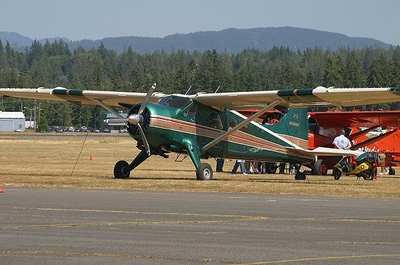Tue, Dec 21, 2021
AD 2021-24-18 Requires Determining Service Life Limits For The Wing Strut Fitting On The Main Spar
The FAA is adopting a new airworthiness directive (AD) for all Viking Air Limited Model DHC-3 airplanes.

This AD results from mandatory continuing airworthiness information (MCAI) originated by an aviation authority of another country to identify and correct an unsafe condition on an aviation product. The MCAI identifies the unsafe condition as fatigue damage of the wing strut lug fitting components and the fuselage to wing strut attachment (tie-bar). This AD requires determining service life limits for the wing strut fitting on the main spar and for the tie-bar and following instructions for removal and replacement of affected parts. The FAA is issuing this AD to address the unsafe condition on these products. This AD is effective January 24, 2022.
Supplementary Information: The FAA issued a notice of proposed rulemaking (NPRM) to amend 14 CFR part 39 by adding an AD that would apply to all Viking Air Limited Model DHC-3 airplanes. The NPRM published in the Federal Register on June 28, 2021 (86 FR 33916). The NPRM was prompted by MCAI originated by Transport Canada, which is the aviation authority for Canada. Transport Canada has issued AD CF-2017-29, dated August 24, 2017 (referred to after this as “the MCAI”), to correct an unsafe condition for Viking Air Limited Model DHC-3 airplanes.
The MCAI states:
- It has been determined that the current maintenance program does not adequately address potential fatigue damage of the wing strut lug fitting components or the fuselage to wing strut attachment (Tie Bar). Affected parts must be replaced before specified air time limits are reached to avoid fatigue cracking of the affected parts. Cracking which is not detected may compromise the structural integrity of the wing or the Tie-Bar.
- Fatigue damage occurs more rapidly on aeroplanes that are operated at higher gross weights. For that reason, the corrective actions of this [Transport Canada] AD must be accomplished sooner for aeroplanes that have been certified for operation at higher gross weights.
- Fatigue damage also occurs more rapidly on aeroplanes that are operated below 2000 feet above ground level (AGL) over land due to higher and more frequent gust and maneuvering loads. Low level flights over water are not known to produce increased fatigue damage on the DHC-3. For that reason, the corrective actions of this [Transport Canada] AD must be accomplished sooner for aeroplanes that have been operated at low altitudes over land.
This condition, if not addressed, could result in cracking and failure of the structural integrity of the wing or the tie-bar.
You may examine the MCAI in the AD docket at https://www.regulations.gov by searching for and locating Docket No. FAA-2021-0214.
In the NPRM, the FAA proposed to require determining service life limits for the wing strut fitting on the main spar and for the tie-bar and following instructions for removal and replacement of affected parts. The FAA is issuing this AD to address the unsafe condition on these products.
More News
Ultrahigh Frequency (UHF) The frequency band between 300 and 3,000 MHz. The bank of radio frequencies used for military air/ground voice communications. In some instances this may >[...]
During The 7 Second Descent, There Was Another TAWS Alert At Which Time The Engine Remained At Full Power On October 24, 2025 at 2115 mountain daylight time, a Cirrus SR22T, N740TS>[...]
From 2009 (YouTube Edition): Educational Organization Aims to Inspire by Sharing Tuskegee Story Founding leader Don Hinz summarized the Red Tail Project’s mission in simple, >[...]
“This feels like an important step since space travel for people with disabilities is still in its very early days... I’m so thankful and hope it inspires a change in m>[...]
Also: New Katanas, Kern County FD Training, IndiGo’s Botched Roster, MGen. Leavitt Named ERAU Dean The Australian Transportation Safety Bureau (ATSB) has wrapped up its inves>[...]
 ANN's Daily Aero-Term (12.19.25): Ultrahigh Frequency (UHF)
ANN's Daily Aero-Term (12.19.25): Ultrahigh Frequency (UHF) NTSB Prelim: Cirrus Design Corp SR22T
NTSB Prelim: Cirrus Design Corp SR22T Classic Aero-TV: The Red Tail Project--Carrying the Torch of the Tuskegee Airmen
Classic Aero-TV: The Red Tail Project--Carrying the Torch of the Tuskegee Airmen Aero-News: Quote of the Day (12.19.25)
Aero-News: Quote of the Day (12.19.25) Airborne 12.17.25: Skydiver Hooks Tail, Cooper Rotax Mount, NTSB v NDAA
Airborne 12.17.25: Skydiver Hooks Tail, Cooper Rotax Mount, NTSB v NDAA



